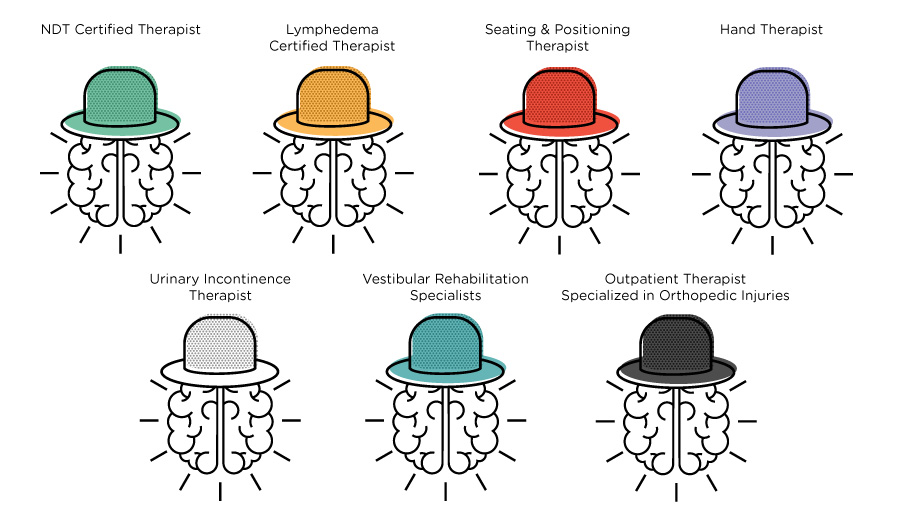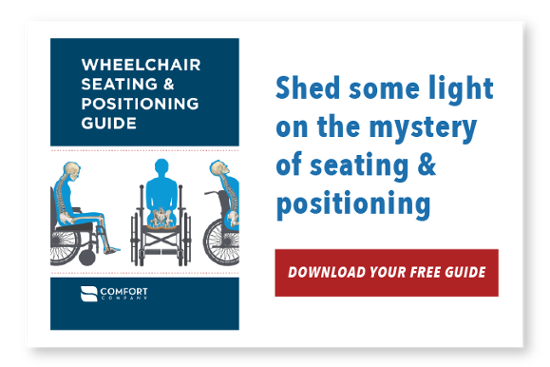Home health care is on the rise as a viable option for therapy especially as the health model shifts from fee-for-service to value based care. Inpatient rehab stays are getting shorter and therapy is increasingly being provided at home due to the significant cost-savings 1,2). Permobil understands that home health is a unique setting, and we want to address the specific challenges to providing seating and wheeled mobility interventions in the home. In today’s blog, we’re discussing why home health therapists may feel ill-equipped to providing these services when asked to do wheelchair or seating evaluations.
Let’s start with a question: why is wheelchair seating so scary and intimidating? I believe there are two main challenges to becoming an experienced and confident seating and positioning therapists.
Challenge #1: Principles of Seating and Wheeled Mobility Not Taught in School
First of all, there is really limited exposure to seating and positioning in therapy programs. One of my colleagues once contacted 4 top OT Masters programs in the country and asked them each how much time was allotted to seating and wheeled mobility. What she found was that therapy programs might have one, maybe two days dedicated to wheeled mobility. But, the focus of these one or two days tends to be more on the experience of being a wheelchair user rather than the principles of seating and wheeled mobility, how to correctly position the wheelchair user, or how to select the proper equipment for a specific user.
challenge you to think of any setting where you don’t need to at least have some level of basic knowledge. Think of a long term care setting where residents are seated in wheelchairs everywhere you look. Most of those residents are in abnormal postures and have residual health effects from prolonged sitting in those postures. Think of a hospital neuro unit where therapists are caring for patients who have suffered a CVA or traumatic brain injury. Often these patients need some type of wheeled mobility and it’s up to the therapist to determine what type as well as select appropriate seating. Consider a VA hospital where veterans with all kinds of diagnoses are coming for therapy. Being able to identify the need, then select the appropriate seating and wheeled mobility is critical in providing the best therapy services to optimize independence and function. Even an outpatient therapist will be faced with addressing wheeled mobility at times. A colleague shared a story about her PT friend who did dry needling and pain management in an outpatient clinic. He had a woman come in a wheelchair complaining of pain. Thankfully he was able to identify that she was sitting in an ill-fitting wheelchair that may be contributing to her pain and was certainly affecting her function. He was able to make the appropriate referral that got her the specialty services she required. As OT’s and PT’s we will inevitably be faced with providing these services, even though we were not taught the principles in school.
Challenge #2: Home Health Therapists Wear Many Hats
Home health therapists see clients with a wide range of diagnoses and need to be knowledgeable in various specialty areas. As a result, most therapists cannot focus all of their CEUs in seating and wheeled mobility alone. A home health therapist may show up to their first appointment of the day and it’s a client who has suffered a stroke requiring neuro expertise. Then, the next client has lymphedema and requires lymphedema expertise. The next client has had a hip replacement and requires ortho expertise.

Every client in a day requires a different therapy practice area and the therapist is expected to be knowledgeable in each one. Usually therapists will take CEU courses related to a variety of treatment practices rather than focusing on one area. Additionally, seating and wheeled mobility seems to be an afterthought since it wasn’t a focus in the therapy training. I’ve had many colleagues in home health who have told me “I don’t do wheelchairs. I didn’t learn that in school. Someone else can do it”. With the current shifts in healthcare home health therapists can no longer say “Someone else will do it”. The trend continues of clients being discharged at higher acuity levels and there is not enough time in inpatient rehab to determine the most appropriate seating and wheeled mobility. This leaves the burden of identifying, trialing, and ordering the most appropriate seating and wheeled mobility equipment on the home health therapist.
This is why we have developed this series and a number of resources to let home health therapists know you’re not alone! Stay tuned for the rest of the series and check out our resources designed to walk you through the process. Next week we’ll start at step one which is addressing seating and wheeled mobility misconceptions and will dive into why “someone else will do it” won’t cut it anymore.
References
1. Landers, S., Madigan, E., Leff, B., Rosati, R., McCann, B., Hornbake, R., MacMillan, R., Jones, K., Bowles, K., Dowding, D., Lee, T., Moorhead, T., Rodriguez, S., Breese, E.(2016). The future of home health care: A strategic framework for optimizing value.Home Health Care Management & Practice, 28(4), pp 262-278. doi: 1177/1084822316666368
2. DeJong, G. (2016). Coming to terms with the IMPACT Act of 2014. American Journal of Occupational Therapy, 70(3), pp 1-6. doi:10.5014/ajot.2016.703003
Icon made by Freepik from www.flaticon.com
 Stacey Mullis, OTR/ATP
Stacey Mullis, OTR/ATP
Director of Clinical Marketing
Stacey serves as Director of Clinical Marketing for Permobil. A practicing OTR for over 20 years, she has experience in school-based pediatrics, inpatient rehabilitation, long term care, and home health. With her interest in wheelchair seating and positioning, Stacey engaged the challenges of providing appropriate seating in various clinical settings. She now uses this experience to develop programs and resources to educate clinicians on the principles of seating and wheeled mobility. She is passionate about equipping clinicians and through her previous role as Director of Clinical Education with Comfort Company and now with Permobil she has taught nationally and internationally to increase therapist capacity in this specialty area. Mullis graduated from Western University in London, Ontario, Canada with a BA Linguistics and BSc Occupational Therapy. She is a member of the NCOTA, CTF Executive Board, NRRTs, RESNA, and AOTA.

